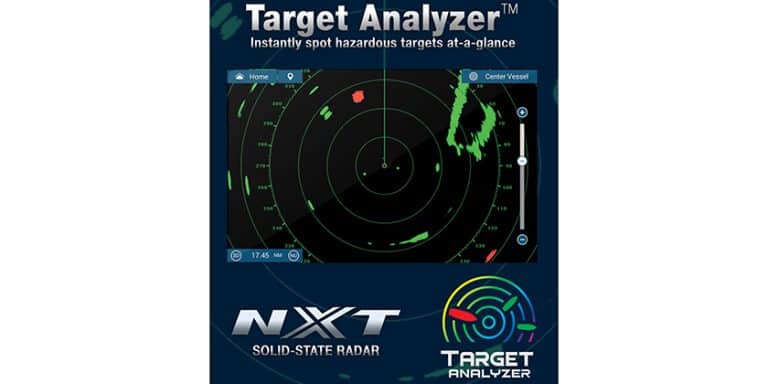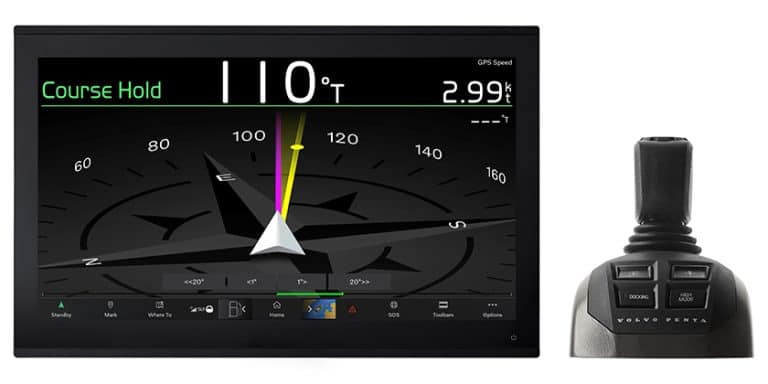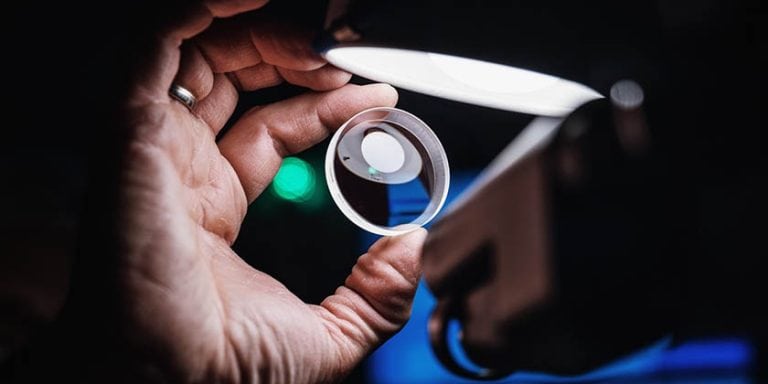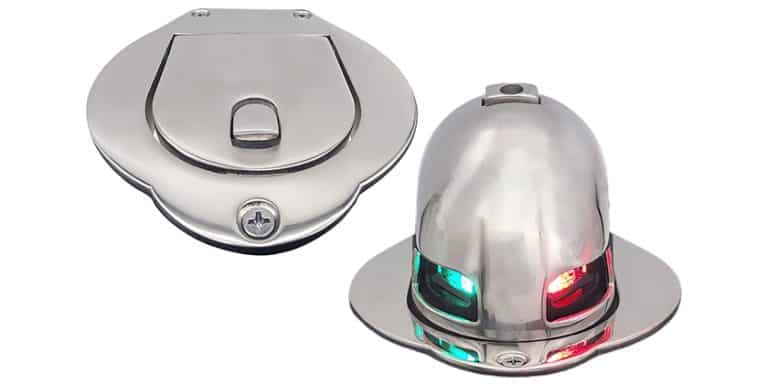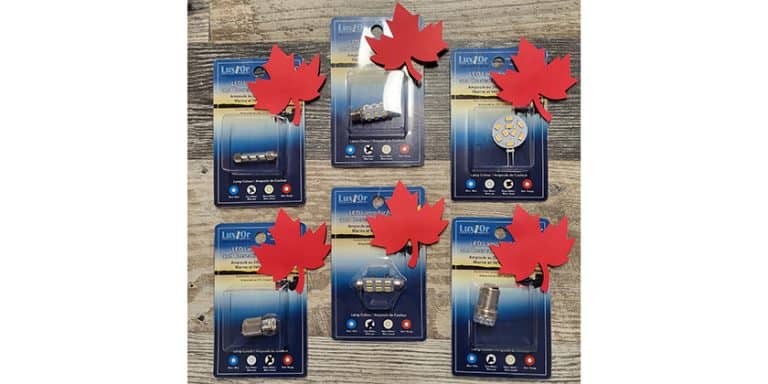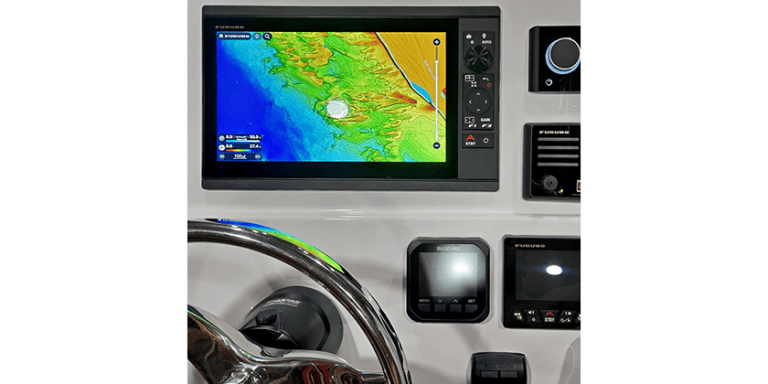Meeting in the Middle
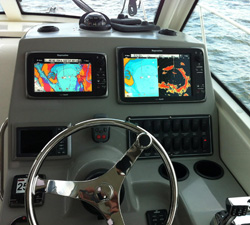
By Lorne Spence
Most people who buy a 60’ yacht aren’t too worried about how much the electronics add-on package is going to cost. After all, what’s another $30,000 when you’re already in for a million? Many of us fall into a more moderate category, with 25’ to 35’ vessels, some brand-new, some used. If this is where you’re at, deciding which electronics to put on the boat means a process of trying to get the most function for the lowest price. Fortunately, new marine electronics make this easier than ever before, with lots of flexibility and value.
We decided to look at outfitting a new Boston Whaler 285 Conquest. It’s on the higher end price-wise, but it’s a fairly typical size and a great platform on which to base a new electronics suite. This particular boat was equipped with new state-of-the-art Raymarine eSeries displays, complete with radar, sonar, autopilot and engine interface. Although different manufacturers have different ideas and approaches to marine electronics, the past five years have seen many of these ideas come into alignment with one another resulting in ‘system building’ being more homogenous. In the following we’ll look at how you can build a system that will do what you need without breaking the bank.
System Overview
Firstly, here’s a quick synopsis of what’s on the boat. There are two Raymarine eSeries displays; an e125 and an e95. They are networked together via Raynet, Raymarine’s high-speed data connection, which is also connected to the RD424HD radar. The SPX10 Autopilot is connected through Seatalkng, Raymarine’s version of NMEA2000. An S100 Remote provides mobile control of the autopilot. We’ll break the system down into pieces, briefly talk about each part, and discuss how they can work to your advantage.
The Multi-Function Display
The heart of any modern marine electronics installation is the Multi-Function Display (MFD). Gone are the days of specific purpose screens, replaced now by displays that allow you to switch though different applications, or even view multiple applications simultaneously. Sizes vary from 6” all the way up to 16” and beyond, but the theory is the same: this is where you view your information. The two eSeries on the Whaler are part of Raymarine’s HybridTouch line. They allow the user to fully control the unit from the touchscreen, but also to do everything from the manual keypad. The keypad is key, excuse the pun. Just ask anyone who’s ever tried to enter a waypoint on a touchscreen in 4 foot plus waves. Sometimes you just need the accuracy a keypad can bring. That being said, the touchscreen is also just as important in today’s world. With almost all of our cell phones being touchscreen, we’re used to being able to just press on what we want to do. It’s intuitive, and in the majority of sea conditions, it just works.
Basically all MFD’s have a built in chartplotter, and many now come with a built in GPS. The GPS in the Raymarine eSeries is a major step forward from the ones in the previous generation. We saw an HDOP of 0.6 (very good, trust me) and they acquired a fix easily under a canvas top. The GPS will work through thin fibreglass and glass windows as well.
The Chartplotter
Most boaters have used a chartplotter before, benefitting from how much they simplify navigation. Once you’ve plotted waypoints, laid out a route and stored the track from your vacation, it’s clear how superior the chartplotter is compared to strip charts with the occasional coffee stain. For some boaters, an MFD is all you need. The GPS and chartplotter covers 75% of basic navigation needs, and if you’re a fair-weather sailor who doesn’t fish you should be fine. Keep in mind, you’re still required by law to have paper charts on board.
Connecting The Components
Many of us want to take things a little further however. The biggest advantage of modern marine electronics is how easily different components network and talk to one another. The Raymarine system on the Whaler is no exception with all systems being tied together. Adding the second screen immediately doubles the amount of area you have on which to view data. Put the radar on one and the chartplotter on the other, or mix sonar and plotter on one and put engine instrumentation on the other. There are many different ways to lay it out.
This is when the real flexibility and advantage of a Multi-Function Display become clear. It does have its limits though, as the more times you split the screen to add another application, the smaller each of those applications becomes. If you’re planning on running multiple applications the majority of the time, it makes sense to invest in a second screen. And once again, with the display networked, any info that’s available on one screen will also be available on the other, including cartography.
Add An Autopilot
Autopilots are quickly becoming known as an indispensible add-on in many boats. For sailors, it’s the smart version of the wheel clamp that can drive while you adjust the sails. For power boaters, if you’re on a long cruise it’s nice not to be confined to the helm. It’s especially helpful for fishermen as it steers while you’re winding in your catch, as well as performing a myriad of trolling manoeuvres such as clover-leafs, spirals and zig-zags, all designed to entice the big one to take the bait.
We’ve heard people say many times, once you have an autopilot, you’ll never want to go without one. So, if you’re doing a lot of one or two person cruising, you could be very glad you added it to your system as it’s like adding another crew.
Radar For Pleasurecraft
Radar is another addition that can be worth the money in the right circumstances. It can be very beneficial to those boating in busy areas due to its assistance in collision avoidance. Sailboats are required by law to have a radar reflector, and power boats typically give a good reflection, meaning it will generally give you a good idea of who is around you. With features like MARPA (an intelligent target tracking feature) and guard zones (alarm will sound whenever the radar sees something within a certain range), a radar will allow you to make course corrections before it’s too late. It also helps in finding navigation markers, and in tracking storms. With entry level pricing not much over the $1000 mark, you can get a lot of capability for those dollars. Raymarine’s new HD Digital Radar provides target resolution not previously available on a dome radar, and the 18” or 24” footprint is perfect for the mid-size vessel.
Depth Meters And Sonar
Probably the most popular upgrade in a navigation system is sonar. A critical feature for those who want to venture off the beaten path; knowing there’s more than 10’ below the keel can give a certain peace of mind. Choosing between a depth meter and a sonar depends on what you want to do with it. A depth meter is good for those who just want a number telling them how deep it is, versus sonar that will not only tell you depth, but can tell you what the bottom is comprised of and if there happen to be any fish under you. Knowing the composition of the bottom helps immensely when trying to anchor. Will you have a secure hold in a nice, sandy area, or will you be dragging anchor on a rocky bottom? A little practice interpreting what you see on the sonar can let you know.
The most cost effective way to add a depth sounder is to purchase a unit with the capability built in. Our test boat has a Raymarine e7D for sonar, a 7” touchscreen unit that fully networks with the other MFD’s, allowing its built-in sonar to be shared with them. Buying built-in is cheaper than adding a black-box sonar after-the-fact, but upgrading later means replacing the display. Still, it’s usually worth it.
If you do want the newest sonar equipment, try out Raymarine’s Downvision technology. It’s built into the new Raymarine a78 MFD, and also available as a black box unit, the CP100. It creates an almost 3D-like picture of the bottom, and has been already used to find shipwrecks, plane wrecks, and some other interesting phenomenon.
Starting A Network Onboard
Choosing an electronics package that works for your boat comes down to an adage like this: spend what you need to get where you want to be. Look at the kind of boating you do, and find a combination that gives you the features you want and comes in at a price that fits your budget. What we like currently about modern marine electronics is that we’re on a fairly stable plateau in terms of technology. Older analog gear is gone, and newer digital equipment is here to stay. The equipment you buy today should be able to interface with newer, coming technology for the foreseeable future. Industry standards like NMEA2000 and the emerging OneNet Ethernet standard mean units will play together, and you’ll be able to see almost any of the information on your system in any place you have a display. Networking means adding more is easy. Finally, marine electronics is friendly!
The Raymarine gear installed on the Boston Whaler 285 worked seamlessly. Seeing a fully networked and truly integrated system operate was a pleasure, and it’s something you yourself can build. All at once, or a piece at a time, your perfect system lies somewhere in the middle.
Watch a short video of the products in this article.
Photo Captions
Photo 1: The two eSeries on the Whaler are part of Raymarine’s HybridTouch line allowing the user to fully control the unit from the touchscreen as well as being able to do everything from the manual keypad.

